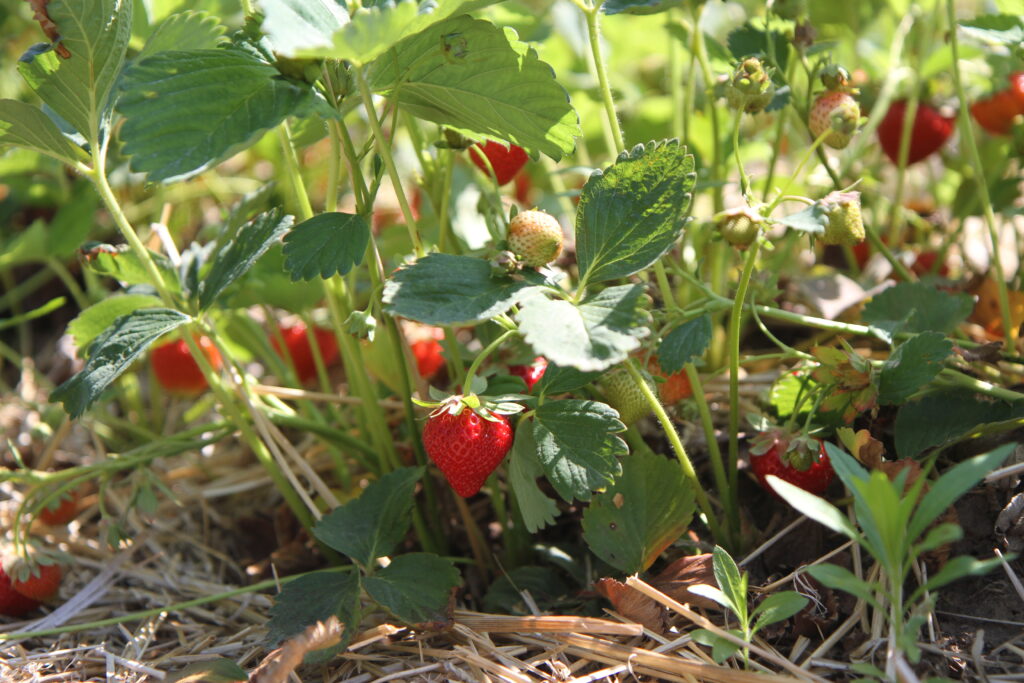
Features
Pest Management
A formidable challenge for N.S. strawberry farmers
April 3, 2024 By Sonny Murray, Perennia berry specialist
 Photo by Alex Barnard.
Photo by Alex Barnard. Strawberry cultivation, although rewarding, is fraught with challenges, and one formidable adversary in 2023 was the sap beetle. This tiny pest, belonging to the Nitidulidae family, has become a significant concern for strawberry farmers in Nova Scotia due to the damage it causes to the fruit crop. As strawberry pests, the sap beetle can include the picnic beetle (beer bug), the strawberry sap beetle and the dusky sap beetle. The dusky sap beetle was the dominant species found in Nova Scotia last year. These beetles can also be minor pests on field and sweet corn, raspberries, blueberries (infrequently) and many over-ripe vegetables.
These beetles can measure three to six millimetres (mm) (1/8-1/4 inch) in length, are oval-shaped and have distinct yellow or orange markings on a brown-to-black background. The head will be entirely brown-black. Most notably, their antennae are club-shaped – this is a key identifying feature that sets them apart from other beetle species.
The sap beetle undergoes complete metamorphosis, which means they progress through four distinct phases: egg, larvae, pupa and adult. Adult beetles typically emerge in spring after overwintering in hedgerows and weedy areas. The adults will hang out in these overwintering areas, feeding on plant sap, pollen and plant material until the crop begins to ripen. The adults then seek out ripe and over-ripe fruit for feeding and egg-laying. The eggs are laid near or on the surface of the fruit and, upon hatching, the larvae burrow into the fruit, causing internal damage. The larvae then pupate in the soil and return as adults in three weeks. There is typically only one generation per year.
Sap beetles are generally not a huge economic pest for Nova Scotia growers. Growers see the odd berry damaged in the field and may confuse it with slug damage or pecking by small birds. Being able to differentiate the damage is key to controlling the pest, as they require very different control measures. Adult sap beetle feeding produces narrow, deep, typically round channels visible to the naked eye. Often, the adult beetles can be found at the bottom of these channels. The shape of the hole caused by slug damage on the fruit is generally more broad compared to that of the sap beetle. Slugs also leave a slime trail and should be found in damp debris not far from the damage.
This past season, harvest was often delayed due to damp weather. This left many strawberries in the field, which was very attractive to the adult beetles. The sap beetle’s primary target is ripe and overripe strawberries. Affected fields were often next to fields that were in field corn the previous year. This indicates a potential connection, as sap beetles will feed on corn that has experienced damage from European corn borer or corn earworm. In addition to the feeding damage, the fruit is more susceptible to infection by fruit rots.
Regular monitoring of strawberry fields is critical to detect sap beetle presence before damage to the fruit gets out of hand. Large populations of this beetle can be devastating to the quickly ripening crop. Maintaining tight picking intervals and removing overripe fruit from the field, especially in everbearing fields, can reduce the attractiveness of the field and reduce immediate damage. Proper field sanitation can disrupt their life cycle and limit their population.
In severe infestations, there are very limited insecticide control options registered in Canada. Growers spraying for tarnished plant bug may be inadvertently suppressing sap beetle. When selecting insecticides during harvest, it is important to use products with short pre-harvest intervals. Delaying harvest to accommodate longer pre-harvest intervals may mean an increase of older fruit in the field, making the problem worse. The U.S. isn’t in a much better position, with only a couple of products registered for the pest in strawberry.
The sap beetle poses a significant threat to strawberry crops in years when harvest is delayed through direct feeding on the fruit and indirect damage through secondary fruit rots. Effective management strategies include a combination of monitoring, timely harvesting and – when necessary – judicious chemical application if other insect pests are present. By staying vigilant and implementing these strategies, farmers can prevent sap beetle damage to their berry crops and protect their yields. •
Print this page